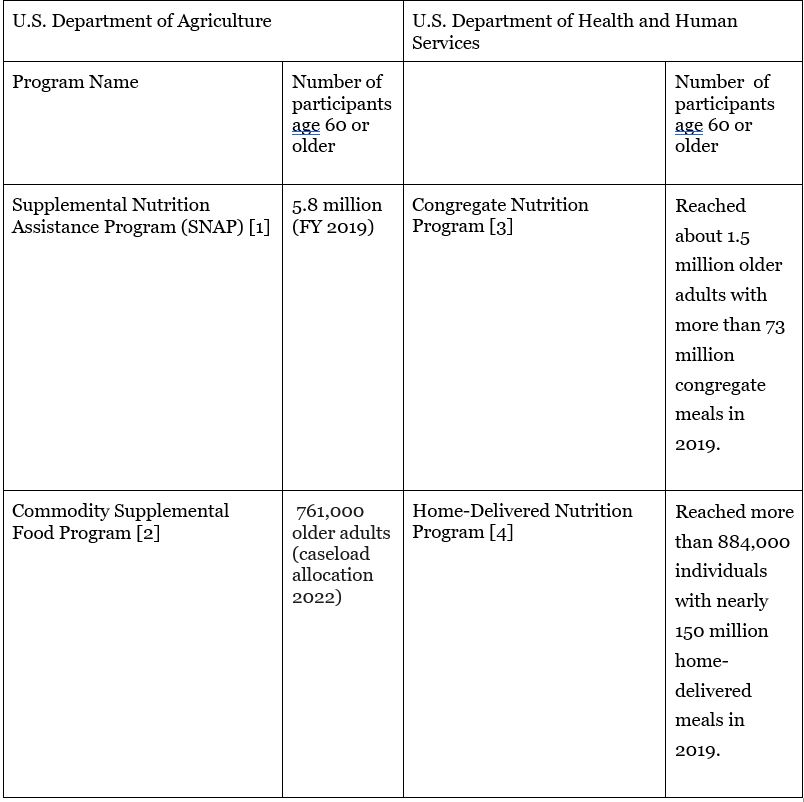May 23, 2022
This blog is part two of a blog series on food insecurity among older adults in recognition of Older Americans Month.
Part 1 focuses on food insecurity’s prevalence among older adults as well as its disproportionate rates among Black and Latinx households and examines risk factors that make older adults more likely to experience food insecurity.
Millions of older adults struggle with food insecurity. Given the harmful impacts of food insecurity on older adult health and well-being, it is critical that stakeholders, including community-based organizations, health providers, and public agencies, connect older adults to the range of available nutrition and food programs. Of paramount importance is connecting them to the Supplemental Nutrition Assistance Program (SNAP), which is the only nutrition program available to all eligible older adults in every part of the country without the need for additional federal appropriations, or subject to a waitlist. A considerable body of evidence shows that SNAP plays a role in improving food security, economic security, health, and diets of older adults by helping them afford to put food on the table. However, one out of every two eligible older adults miss out on the benefits of SNAP.
Key Programs Overview
The key programs available to older adults, age 60 and older, are administered by the U.S Department of Agriculture (USDA) and the U.S. Department of Health and Human Services (HHS). See the chart below for more details.

Your Guide to Navigating the Programs
Supplemental Nutrition Assistance Program (SNAP): SNAP (the program name may vary by state) is available to eligible people of any age, and is a great help for older adults by providing them with money to purchase food.
This money is loaded on to an electronic benefit transfer (EBT) card, which looks and is used like a debit card at participating grocery stores, farmers’ markets, and other food retailers. There are special rules that can make it easier for older adults (age 60 and older) to apply for SNAP.
These programs are especially designed to serve older adults but participation is capped:
Home-delivered meals: Depending on where a person lives, they may be able to get meals delivered to their home. The meals might be hot, frozen, or shelf-stable. This program (also known as Meals on Wheels) is typically for older adults who are homebound and cannot cook or prepare meals.
Congregate meals: Many congregate meals sites (also called “meals with friends” or “community dining”) provide meals to older adults at community dining sites, like senior centers or in senior housing. The Eldercare Locator and Meals on Wheels have information on whether meals are available in your area.
Commodity Supplemental Food Program (CSFP): Some food banks or other organizations provide older adults with a box or bag of staple foods (canned fruits and vegetables, cheese, shelf-stable milk, cereals, potatoes, grains, peanut butter, and dried beans) each month through the Commodity Supplemental Food Program (the program name may vary by state).
These nutrition programs not only reduce food insecurity among older adults, but also improve their nutrition, health, and well-being. FRAC’s Federal Nutrition Programs and Emergency Referral Chart for Older Adults provides additional information on how to access these and additional programs—including The Emergency Food Assistance Program (TEFAP), Senior Farmers’ Market Nutrition Program, and the Child and Adult Care Food Program—available to older adults.
Opportunities to Take Action
In recognition of Older Americans month, there are several actions advocates can take to ramp up your work to address hunger among older adults throughout the year:
- Connect eligible older adults to the range of nutrition programs that support their nutrition, health, and well-being: Promote the importance of SNAP and ensure older adults are accessing SNAP and deducting eligible medical and housing expenses. In addition to helping older adults access SNAP, stakeholders can refer eligible older adults to the range of other federal and local food and nutrition resources that may be available in your areas, including the Commodity Supplemental Food Program, congregate meals, home-delivered meals, and food banks and emergency food sites.
- Engage in broader efforts to address hunger: There are opportunities to make the federal nutrition programs even stronger and improve access for older adults. Sign up for the FRAC Action Network (FAN) to connect with your members of Congress and urge them to take action to end hunger.
- Share your ideas to inform the White House Conference of Hunger, Nutrition, and Health: In September, the White House will be hosting a conference in Washington on hunger, nutrition, and health. Prior to the conference, there will be a series of virtual, regional listening sessions as well as a submission portal for people to share their ideas. Learn more and sign up for email updates about the conference or contact FRAC’s Chief of Staff Etienne Melcher Philbin at emelcher@frac.org.


